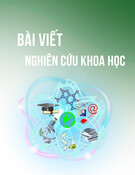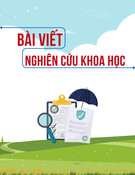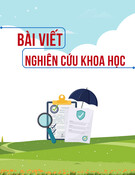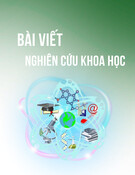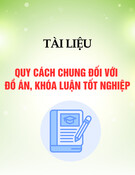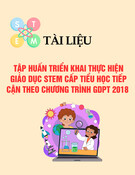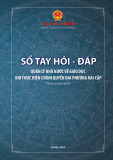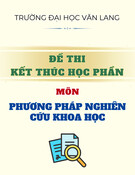
VĂN HÓA https://jst-haui.vn
Tạp chí Khoa học và Công nghệ Trường Đại học Công nghiệp Hà Nội Tập 61 - Số 2 (02/2025)
68
NGÔN NG
Ữ
P
-
ISSN 1859
-
3585
E
-
ISSN 2615
-
961
9
EXPLORING SELF-EFFICACY
OF ENGLISH-AS-MEDIUM-INSTRUCTION TEACHERS
AT A VIETNAMESE PUBLIC UNIVERSITY
TÌM HIỂU VỀ SỰ TỰ TIN CỦA GIẢNG VIÊN DẠY CÁC MÔN CHUYÊN NGÀNH BẰNG TIẾNG ANH
TẠI MỘT TRƯỜNG ĐẠI HỌC CÔNG LẬP Ở VIỆT NAM
Nguyen Thi Kieu Tam1,*
DOI: http://doi.org/10.57001/huih5804.2025.038
ABSTRACT
This paper explores the self-efficacy of English as a Medium of Instruction (EMI) teachers at a public university in Vietnam. It focuses on three key areas of teachin
g:
instructional practices, classroom management, and student engagement. A quantitative approach was employed using the Teachers’
Sense of Efficacy Scale (TSES)
to assess self-efficacy among ten EMI teachers. Data were collected via online questionnaires, and the results were analyzed to examine the
relationship between
teachers' self-efficacy and their instructional strategies, classroom management techniques, and student engagement. The findings reveal high levels of self-
efficacy
across all three dimensions, with teachers expressing strong confidence in motivating students, managing classroom disruptions, and setting clear behaviou
ral
expectations. However, there were mixed results regarding family involvement in student success, indicating an area for impro
vement. Most teachers also
demonstrated confidence in using diverse instructional strategies, though there is room for growth i
n diversifying assessment methods. The study highlights both
the strengths and potential areas for development in supporting EMI teachers to enhance their self-efficacy, particularly in engaging families in the learning process.
Keywords: Teachers’ self-efficacy, English as a Medium of Instruction.
TÓM TẮT
Bài báo này tìm hiểu về sự tự tin về năng lực của giáo viên giảng dạy các môn chuyên ngành bằng tiếng Anh tại một trường đại học công lập ở Việ
t Nam.
Nghiên cứu tập trung vào ba lĩnh vực chính trong giảng dạy: phương pháp giảng dạy, quản lý lớp học và sự tham gia của sinh viên. Nghiên cứu áp dụ
ng phương
pháp nghiên cứu định lượng, sử dụng thang đo năng lực giảng dạy của giáo viên để đánh giá sự tự tin về năng lực của mười giáo viên. Dữ liệu được thu thậ
p qua
một khảo sát trực tuyến, kết quả được phân tích nhằm nghiên cứu về mối quan hệ giữa sự tự tin về năng lực của giáo viên và các phương pháp giảng dạy, kỹ
thuật quản lý lớp học cũng như sự tham gia của sinh viên. Kết quả cho thấy mức độ tự tin cao về năng lực của giao viên. Tuy nhiên, kết quả về việc phối hợp vớ
i
gia đình trong việc giúp sinh viên trong việc học lại có sự khác biệt, cho thấy đây là một khía cạnh cần cải thiện. Hầu hết giáo viên cho thấy sự tự tin trong việc s
ử
dụng đa dạng các phương pháp giảng dạy. Nghiên cứu nhấn mạnh cả những điểm mạnh và những khía cạnh tiềm năng cần phát triển trong việc hỗ trợ
giáo viên
EMI nâng cao sự tự tin về năng lực, đặc biệt là trong việc thu hút sự tham gia của gia đình vào quá trình học tập.
Từ khoá: Sự tự tin của giáo viên, giảng dạy các môn chuyên ngành bằng tiếng Anh.
1School of Languages and Tourism, Hanoi University of Industry, Vietnam
*Email: tamntk@haui.edu.vn
Received: 15/11/2024
Revised: 15/01/2025
Accepted: 27/02/2025
1. INTRODUCTION
The adoption of English as a Medium of Instruction
(EMI) in universities has recently emerged as a global
educational trend. Many Asian countries, including
Vietnam, have implemented EMI to enhance
international competitiveness in higher education. One

P-ISSN 1859-3585 E-ISSN 2615-9619 https://jst-haui.vn LANGUAGE - CULTURE
Vol. 61 - No. 2 (Feb 2025) HaUI Journal of Science and Technology
69
of the public universities in Vietnam, Hanoi University of
Industry (HaUI), has employed EMI as a strategic initiative
to improve educational quality and support efforts
toward international integration.
The transition to EMI teaching presents distinct
difficulties for teachers, as they must simultaneously
manage content delivery, language proficiency, and
pedagogical effectiveness. The teachers’ self-efficacy-
their beliefs in their ability to effectively plan and execute
tasks in the classroom- becomes crucial in this setting.
However, the research examining the EMI teachers’ self-
efficacy in Vietnamese higher education remains limited.
The present study aims to address this gap by
exploring the self-efficacy of EMI teachers at HaUI and
concentrating on the key aspects of teaching:
instructional practices, classroom management, and
student engagement. By exploring EMI teachers’ self-
efficacy, this study sheds light on the challenges and
opportunities faced by the teachers and how they can
enhance their self-efficacy in teaching EMI classes.
2. LITERATURE REVIEW
2.1. English as a Medium of Instruction (EMI)
English as a Medium of Instruction (EMI) has recently
emerged as a significant global educational trend.
Therefore, it is understandable that EMI has gained such
great attention leading to various definitions of EMI
proposed by different researchers. The core concept
involves using English to teach academic subjects in
contexts where it is not the primary language [1, 2]. EMI
refers to the instruction of subjects through English
without explicit language learning objectives, typically in
a country where the majority of the population does not
speak English.
Additionally, EMI is viewed as a teaching and learning
strategy that emphasizes both non-language subject
matter and language, encompassing communication and
cognitive aspects [3, 4].
Researchers have also proposed various modalities of
EMI: full EMI, where native languages are excluded, and
partial EMI, where less than 50% of the curriculum is in
English [5].
The varying implementations of EMI, ranging from full
to partial, introduce distinct challenges for educators,
directly impacting their sense of self-efficacy in EMI
teaching. As instructors confront the complexities of
delivering subject content in a non-native language, their
confidence in their ability to effectively convey subject
matter becomes crucial. This is particularly pertinent in
contexts where English is not the dominant language, as
noted by [2]. The absence of explicit language learning
objectives in EMI, along with the need to maintain
academic rigour, requires teachers to possess not only
advanced English language skills but also the belief in
their capacity to adapt their pedagogical strategies.
Therefore, investigating teacher self-efficacy in EMI
settings becomes essential for understanding how
educators can successfully implement EMI programs.
2.2. Teacher self-efficacy
Self-efficacy is based on social cognitive theory, which
highlights the significance of cognitive processes in
shaping how individuals perceive and respond to their
environment [6]. According to this theory, individuals are
active agents capable of influencing and forming their
behaviours, thoughts, and emotions [7]. Self-efficacy is
defined as one's belief in their capacity to effectively plan
and execute the actions needed to attain specific goals
[8]. This concept emphasizes the role of personal
judgment in evaluating one's ability to perform specific
tasks or achieve desired outcomes. Further refining this
concept, Bandura characterized self-efficacy as an
individual's confidence in their competence to execute
particular actions and realize intended outcomes [9].
It refers to the belief that people can accomplish
specific tasks, deal with problems, and attain goals. This
belief is significant in determining people's actions, the
effort they invest, and their persistence when confronted
with challenges [10, 11]. In educational contexts, teachers’
efficacy includes their convictions and confidence in their
ability to effectively fulfil their professional responsibilities
and positively influence their student’s academic
development and overall growth [12, 13].
Teacher self-efficacy significantly influences
pedagogical strategies, classroom management
techniques, and overall educational approaches [14, 15].
It is fundamental in determining teachers’ confidence in
their capacity to actively engage their students in the
learning process. Teachers who are highly effective at
engaging their students show confidence in their
capacity to stimulate intellectual curiosity, foster
enthusiasm for academic pursuits, and cultivate an
enduring appreciation for knowledge acquisition.
Given the profound impact of teacher efficacy on
motivation, perseverance, and pedagogical
methodologies, it can be understandable that high
teacher efficacy, particularly within EMI contexts, would

VĂN HÓA https://jst-haui.vn
Tạp chí Khoa học và Công nghệ Trường Đại học Công nghiệp Hà Nội Tập 61 - Số 2 (02/2025)
70
NGÔN NG
Ữ
P
-
ISSN 1859
-
3585
E
-
ISSN 2615
-
961
9
be a topic of research interest. However, empirical
research regarding educators' self-perceived efficacy in
EMI settings is scarce.
3. METHODOLOGY
3.1. Research site and participants
The selected participants in this study are 10 EMI
teachers, including 3 males and 7 females, from a
Vietnamese public university, particularly Hanoi
University of Industry. All participants possessed an
average of 5 years of teaching experience and were an
average age of 28. Additionally, they were sourced from
different academic backgrounds. The survey was
completed voluntarily, and the responses were kept
extremely confidential and anonymous.
3.2. Research methods
This study used a quantitative approach; the Teachers’
Sense of Efficacy Scale (TSES) was employed popularly to
evaluate teachers’ self-efficacy [16]. It has been broadly
validated and utilized in various studies across diverse
educational settings. In this study, the 12-item version of
TSES was administered online with the researcher
present to ensure clarity. The questionnaire was delivered
in English to maintain consistency and accuracy in
responses. This version of TSES was employed to address
the question:
How does the self-efficacy of EMI teachers relate to their
instructional strategies, classroom management, and
student engagement?
To be more specific, the study investigates three
dimensions: the relationship between EMI teachers' self-
efficacy and their instructional practices, classroom
management strategies, and student engagement. Table
1 illustrates the aims of each question.
Table 1. The aims of each question
Aims Items
Efficacy in Student Engagement (SE) 2,3,4,11
Efficacy in Instructional Strategies (IS) 5,9,10,12
Efficacy in Classroom Management (CM) 1,6,7,8
Student engagement is defined as the extent of
attention, curiosity, enthusiasm, optimism, and passion
students demonstrate during learning activities and
teaching processes. It also encompasses the students'
motivation to learn and advance academically. In general
terms, the concept of student engagement is based on
the idea that students learn better when they are curious,
interested, or inspired while learning outcomes tend to
decline when students feel bored, indifferent,
uninterested, or otherwise disconnected from the
educational experience [17]. Instructional practices refer
to the methods and approaches teachers use to deliver
content, clarify concepts, and facilitate learning
effectively. Instruction has previously been described as
the intentional guidance of the learning process and
represents one of the primary classroom responsibilities
of teachers, alongside planning and management.
Educators have created numerous instructional models,
each aimed at facilitating effective classroom learning
outcomes [18]. Lastly, classroom management strategies
encompass the teachers' ability to organize the
classroom environment, manage student behaviours
proactively, maintain discipline, and create a positive
atmosphere conducive to learning.
3.3. Data collection procedures
The study collected data from 10 EMI teachers at a
Vietnamese public university using online questionnaires
for a broad approach and convenience. The TSES was
distributed to 25 teachers and received 10 responses. To
make sure that the participants fully understood the
questions, the researcher was presented to promptly
explain the vague information if necessary.
3.4. Data analysis
Step 1: Once the answers were sent, the researcher
checked whether the survey was completed or not and
whether the answers were consistent.
Step 2: Items that helped indicate the answer to SE, IS,
and CM were grouped separately. Descriptive analysis
was employed to seek insight into data variables
Step 3: The resulting groups were then interpreted
using graphs, tables, or charts
4. FINDINGS AND DISCUSSIONS
4.1. Findings
4.1.1. EMI teachers’ self-efficacy in Student
Engagement
Regarding the teachers’ sense of efficacy in
motivating and assisting students, the data presented in
Table 2 shows a positive tendency. Specifically, in
responses to question 2 - “How much can you do to
motivate students who show low interest in school
work?”, the dominant (70%) indicated that they could
“quite a bit” motivate students. The remaining 30%
reported having “some influence.”. Similarly, when
considering their ability to encourage students to believe
they can do well in school, 30% selected "Some influence"
while 70% reported "Quite a bit".

P-ISSN 1859-3585 E-ISSN 2615-9619 https://jst-haui.vn LANGUAGE - CULTURE
Vol. 61 - No. 2 (Feb 2025) HaUI Journal of Science and Technology
71
Table 2. Data on efficacy in SE
No.
Questions Nothing
(%)
Very
little
(%)
Some
influence
(%)
Quite
a bit
(%)
A
Great
Deal
(%)
2
How much can
you do to
motivate students
who show low
interest in
schoolwork?
0 0 30 70 0
3
How much can
you do to get
students to
believe they can
do well in
schoolwork?
0 0 30 70 0
4
How much can
you do to help
your students
value learning?
0 0 10 80 10
11
How much can
you assist families
in helping their
children do well in
school?
0 30 40 30 0
Moreover, eight over ten teachers (80%) revealed that
they could “quite a bit” help the students to value
learning, while 10% expressed that they can do a great
deal and another 10% stated that they could have “some
influence” in this regard. This result suggests a strong
sense of self-efficacy in fostering the students’
engagement and belief in learning outcomes.
However, when asked about the teachers’ capacity to
support families in helping their children succeed in
school, the responses were more varied. None of the
participants reported that they could do “a great deal”.
Instead, 40% of them indicated “some influence”, 30%
believed that they could do “quite a bit” and another 30%
reported that they could offer “very little” assistance. This
emphasizes a potential area for enhancing a stronger
teacher-family collective efforts to support the students.
4.1.2. EMI teachers’ self-efficacy in Instructional
Strategies
Table 3 presents data on the group of questions
focusing on assessing the teachers’ self-efficacy in
instructional strategies. In concern of the teachers’ ability
to clarify the students’ behavioural expectations, the
majority of teachers (60%) revealed that they could do
"quite a bit, 30% indicated they could have "some
influence”, and the smaller proportion (10%) a could
make their expectations clear "a great deal." It suggests a
generally high level of self-efficacy among teachers in
setting behavioural expectations.
Table 3. Data on efficacy in IS
No.
Questions Nothing
(%)
Very
little
(%)
Some
influence
(%)
Quite
a bit
(%)
A
Great
Deal
(%)
5
To what extent
can you make
your expectations
clear about
student behavior?
0 0 30 60 10
9
How much can
you use a variety
of assessment
strategies?
0 0 20 70 10
10
To what extent
can you provide
an alternative
explanation or
example when
students are
confused?
0 0 0 70 30
12
How well can you
implement
alternative
strategies in your
classroom?
0 10 30 50 10
In terms of diverse assessment strategies usage
(question 9), a large portion of the teachers (70%)
expressed confidence in employing various methods
"quite a bit”, while 20% reported having "some influence"
and only 10% felt they could do "a great deal". It is
interpreted that while most teachers seem to be
confident in applying different assessment strategies,
there remains room for strengthening their efficacy in
this area.
4.1.3. EMI teachers’ self-efficacy in Classroom
Management
The data in Table 4 shows consistent patterns in
teachers’ self-efficacy regarding classroom management.
In controlling disruptive behavior and enforcing
classroom rules, the results were identical: 60% of

VĂN HÓA https://jst-haui.vn
Tạp chí Khoa học và Công nghệ Trường Đại học Công nghiệp Hà Nội Tập 61 - Số 2 (02/2025)
72
NGÔN NG
Ữ
P
-
ISSN 1859
-
3585
E
-
ISSN 2615
-
961
9
participants indicated that they could influence adhere
“quite a bit”, 30% indicated "some influence", and 10%
claimed "a great deal" of control. This consistency reflects
a relatively high level of self-efficacy in managing
disruptions and establishing rules compliance.
Table 4. Data on efficacy in CM
No.
Questions Nothing
(%)
Very
little
(%)
Some
influence
(%)
Quite
a bit
(%)
A
Great
Deal
(%)
1
How much can
you do to control
disruptive
behavior in the
classroom?
0 0 30 60 10
6
How much can
you do to get
children to follow
classroom rules?
0 0 30 60 10
7
How much can
you do to calm a
student who is
disruptive or
noisy?
0 0 20 60 20
8
How well can you
establish a
classroom
management
system with each
group of students?
0 0 20 80 0
There is slightly higher confidence in the capacity to
calm disruptive or noisy students, compared to the prior
areas, with 20% reporting "a great deal" of influence, and
60% indicating "quite a bit" of influence. This distribution
suggests moderate variation, with a considerable portion
of teachers feeling capable of calming students
effectively. Regarding the establishment of classroom
management systems, 80% of respondents indicated
"quite a bit" of confidence, while 20% reported having
"some influence". No respondents indicated "a great
deal" of confidence, suggesting potential for
improvement in applying management systems across
different student groups.
Notably, no participants selected "nothing" or "very
little" across all questions, indicating a baseline level of
confidence in classroom management abilities. The
majority selection of “quite a bit” (60 - 80%) implies a
generally high level of confidence in classroom
management skills.
4.2. Discussion
The exploration of teachers’ self-efficacy in this study
aligns with and expands upon the previous studies on
teachers’ self-efficacy, specifically in the context of EMI.
The findings of [19] on self-efficacy levels among in-
service teachers in managing various student needs, this
study’s data reveal a strong sense of efficacy among EMI
teachers. These findings reinforce the general trends seen
in broader education contexts, showing the positive role
of teachers’ self-efficacy in motivating students. The
findings regarding the teachers’ confidence in controlling
classroom disruptions also align with [20] who pointed
out that classroom management is a core dimension of
teacher self-efficacy. However, unlike [21] findings, which
identified a strong connection between self-efficacy and
engagement in instructional adaptability, EMI teachers in
this study expressed more modest confidence in
implementing diverse assessment strategies, suggesting
that specific EMI challenges may moderate efficacy in this
area. This indicates that the unique challenges posed by
EMI environments, such as language barriers and
culturally diverse classrooms, may moderate teachers’
self-efficacy in certain areas. These nuances suggest the
need for targeted professional development to bolster
teachers’ confidence and competence in navigating
specific EMI-related obstacles, such as the design and
implementation of diverse and inclusive assessment
techniques. This distinction highlights the complex and
context-dependent nature of self-efficacy in EMI
teaching, providing valuable insights for future research
and teacher training programs.
5. CONCLUSION
The findings reveal a strong sense of self-efficacy
among EMI teachers in three key areas: student
engagement, instructional strategies, and classroom
management. Teachers expressed high confidence in
their ability to motivate students, foster a sense of value
in learning, and encourage engagement. However,
responses related to supporting family involvement were
mixed, pointing to a potential area for development.
In terms of instructional strategies, most teachers
reported feeling effective in setting behavior
expectations, clarifying instructions, and providing
alternative explanations when students faced challenges.
However, enhancing teachers' capacity to diversify
assessment methods could further strengthen their
instructional adaptability. Classroom management data
showed consistently high confidence, particularly in



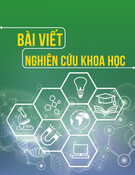


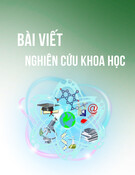


![Câu hỏi ôn tập môn Tâm lý học giáo dục [chuẩn nhất]](https://cdn.tailieu.vn/images/document/thumbnail/2025/20250710/kimphuong1001/135x160/59611752136982.jpg)
